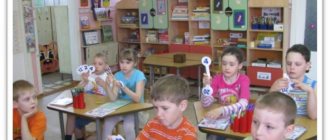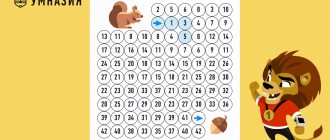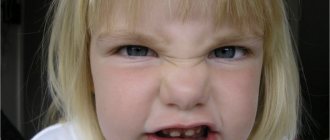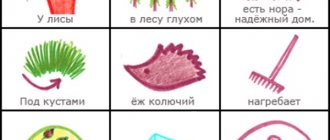Collection of samples of teaching aids for the sections of FEMP “Quantity and Counting”, “Quantities”
state budgetary professional educational institution
Rostov region
"Zernograd Pedagogical College"
Collection of samples of teaching aids for the sections of FEMP “Quantity and Counting”, “Quantities”
Zernograd 2022
Compiled by:
Angelina Ivanova, student 4 B group, specialty “Preschool Education”
Supervisor:
Oksana Aleksandrovna Globina, teacher of the professional cycle of the highest qualification category at the State Budgetary Educational Institution of Regional Educational Institution “ZernPK”.
The proposed collection is compiled in accordance with the Federal State Educational Standard for Secondary Professional Education in specialty 440201 “Preschool Education” and in accordance with the work program MDK 03.04. “Theory and Methods of Mathematical Development of Children” is intended for both individual and group activities of students specializing in “Preschool Education” in the educational process of the Zernograd Pedagogical College, as well as for educators, methodologists of preschool educational institutions and parents of preschool children.
This collection includes a number of samples of teaching aids on the sections of FEMP “Quantity and Counting”, “Quantities”, which contribute to the correct organization of direct educational activities of preschoolers in mathematical development.
TABLE OF CONTENTS
Introduction
Samples of teaching aids for the FEMP section “Quantity and Counting” in the junior group
Samples of teaching aids for the FEMP section “Quantity and Counting” in the middle group
Samples of teaching aids for the FEMP section “Quantity and Counting” in the senior group
Samples of teaching aids for the FEMP section “Quantity and Counting” in the preparatory group
Samples of teaching aids for the FEMP section “Magnitude” in the junior group
Samples of teaching aids for the FEMP “Value” section in the middle group
Samples of teaching aids for the FEMP “Magnitude” section in the senior group
Samples of teaching aids for the FEMP “Magnitude” section in the preparatory group
INTRODUCTION
The
mathematical development of preschoolers should be understood as shifts and changes in the cognitive activity of the individual that occur as a result of the formation of elementary mathematical concepts and related logical operations.
The formation of elementary mathematical concepts
is a purposeful and organized process of transferring and assimilating knowledge, techniques and methods of mental activity (in the field of mathematics).
Samples of teaching aids for the FEMP section “Quantity and Counting” in the junior group
Samples of teaching aids for the FEMP section “Quantity and Counting” in the middle group
Samples of teaching aids for the FEMP section “Quantity and Counting” in the senior group
Samples of teaching aids for the FEMP section “Quantity and Counting” in the preparatory group
Samples of teaching aids for the FEMP section “Magnitude” in the junior group
Samples of teaching aids for the FEMP “Value” section in the middle group
Samples of teaching aids for the FEMP “Magnitude” section in the senior group
Samples of teaching aids for the FEMP “Magnitude” section in the preparatory group
Literature
- Kozlova, S.A. Preschool pedagogy [Text]/ S.A. Kozlova, T.A. Kulikova. – M.: “ACADEMY”, 2015 with changes. – 432s.
- Freilakh, N.I. Methodology of mathematical development [Text]/ N.I. Freilach. – M.: Publishing House “FORUM”, 2014.- 240 p.
Entertaining books on mathematics for preschoolers
Lyudmila Vishnyakova
Entertaining books on mathematics for preschoolers
Slide 2
Mathematics is the “queen of sciences”
, she prefers accuracy, conciseness, specificity and abstraction.
Teaching a child to think, to find a way out of non-standard situations, not only mathematical ones , but also unwritten, life ones, is the task not only of the school and kindergarten, but first of all of the parents.
What is fun math ? Entertaining mathematics for preschoolers is an interesting and exciting activity. Mathematics for kids begins with familiarization with numerical quantities and numbers. This knowledge base is necessary for a child even before entering school. Therefore, help from parents is necessary specifically in elementary school and in the preschool period . Starting from an early age, children need to be interested in arithmetic as a science. After all, mathematics for the little ones begins at home. Preschoolers of this age must realize that objects can be counted and the number of objects can be called a number. Organization of mathematical activities of preschool children through the use of entertaining books , which can and should be used in classes with children in a family setting. Introducing this subject in a playful and entertaining way will help the child prepare for school faster and easier in the future.
Joint activities in the family to develop elementary mathematical concepts in a child bring the following positive results:
SLIDE 3
- awaken parents’ interest in the level of mental development of children and contribute to the development of logical thinking, memory, attention, and fine motor skills in children in accordance with their age and abilities;
— deepen the relationship between parents and children, unite the family, serve mutual enrichment;
- create in the family an atmosphere of mutual attention and business cooperation, which is so necessary for solving any educational problems;
- allow the free time that the mother or father devotes to the child to be spent usefully;
– contribute to the comprehensive development of the child (persistence in achieving goals, perseverance)
and are beneficial for the child’s mental state;
Entertaining mathematics for preschoolers
The formation of “scientific thinking” begins to take shape from the earliest stages of a child’s development. From the cradle, we let children feel objects of different textures, shapes and colors, doing the simplest massage, counting fingers, telling fairy tales, reading books.
Many of these fairy tales and books actually contain a lot of real mathematical information .
Slide 4
The most trivial example of a “ mathematical ” fairy tale is, of course, “The Turnip.” With the help of this fairy tale, for example, such an important idea from mat is formed. analysis, as “an increase in the infinitesimal,” or, say, the philosophical concept of “the transition of quantity into quality.” They also remind me of the fairy tale about the Three Bears, and in general, I must say that the numbers 3, 4 and 7 in fairy tales are very, very popular!
Among the author's fairy tales there are those in which much attention is paid to mathematical concepts :
Slide 5
The book “The Adventures of Treugoshi: A mathematical fairy tale for children from 2 to 4 years old”
Three-year-old boy Misha invents and draws a fairy-tale hero - Treugosh. Treugosha goes on a journey, during which various funny stories happen to him.
Children from 2 to 4 years old, listening to a fairy tale, looking at illustrations and answering questions, master basic mathematical knowledge , which will be useful to them in preparing for school.
SLIDE 6
In the book “Juventik in the land of numbers and figures” for children from 4 to 7 years old
This book presents entertaining tasks that develop spatial imagination and logical thinking preschoolers Kids solve examples and problems, perform graphic dictations, complete missing parts of objects, establish cause-and-effect, logical connections and patterns.
The main goal of the book is to develop a preschooler's interest in mathematics .
Slide 7
The pearl among mathematical books for the little ones is, of course, the famous series about Kubarik and Tomatik - books one and two .
An interesting fairy tale that will make it easier for a child to learn simple mathematical operations , such as “more”, “less”, “equal”, “circle”, “square”, etc. Bright color pictures will not only interest the child, but will also give a positive result in learning .
The book is a preparatory stage of the author’s educational program “ Mathematics for Preschoolers ”.
Slide 8
Georgy Yudin’s book “ Entertaining ”: “ Entertaining mathematics for girls and boys 4-7 years old. " Zanimatika " is the cheerful little sister of arithmetic. It will help children not only quickly memorize numbers and solve simple problems with them, but will also give them their first understanding of the theory of relativity, space, time and, most importantly, teach them to think creatively and find the right solutions both in arithmetic and in life. » Fun educational tasks will help your child develop motor skills, imagination, lateral thinking, logic, counting and attention. The tasks are compiled taking into account the age characteristics of children and are structured according to the principle from simple to complex.
For children 6-7 years old, tasks are presented: cross out the extra, solve examples, show the necessary figures, find the shadow of the figure, cross out the extra number, write counting in twos, threes, tasks for understanding time, tasks for spatial imagination, color so that they are not the same, continue the row, counting from 10 to 20.
Slide 9
Books will also be useful for parents to teach their children a preschooler’s life . Each age has its own color, its own gnome, its own books . For example, all books for children aged 1-2 years have blue covers. Seven years before school - seven colors of the rainbow. The manuals have been developed in accordance with modern educational standards and will be useful to both parents and specialists: educators, methodologists. The set includes the books : “Whose voice is this?”, “Color. Shape”, “Big, small”, “Plasticine snowball”, “Cheerful, sad”, “My house”, “Finger painting”, “In the village and in the country”, “Walking around the city”, “Whose tail is this?” , “My first dictionary”, “Who is this, what is this?”.
The manuals are developed in accordance with modern educational standards.
Slide 10
Based on the book Irina Vladimirovna Maltseva MATHEMATICS FOR PRESCHOOL CHILDREN FROM A TO Z
You can teach your child quickly and with pleasure: count within 10, compare sets, reason logically, analyze, add and subtract, solve problems, explore the world.
Slide 11
“Together we learn to count. Entertaining mathematics for preschoolers . Workbook No. 2. Federal State Educational Standard"
Fun math workbooks will help kids learn basic math in a fun way. Together with the game characters Ryzhik the fox and Fluffy the bunny, children will become familiar with numbers, remember their sequence, learn to count to ten, and compare objects by size and shape.
The manual promotes the development of visual perception, voluntary attention, the formation of the first skills of analysis and comparison, and the improvement of fine motor skills.
Slide 12
Entertaining mathematics for preschoolers should form children's first mathematical knowledge , consolidate the skills of quantitative and ordinal counting, and first calculations using addition and subtraction operations.
Fun math should last no more than 15 minutes a day. You can learn to count not only at your desk, but also in the yard, counting, for example, children on the playground and steps in the entrance, and even at lunch, arranging pieces of potatoes in a bowl of soup.
You have entered this section, which means you do not need to explain why you should study mathematics with children and how useful it is. You just give it half an hour every now and then (or regularly) and want to keep up with good worksheets.
The manuals provided in this collection can be used:
— to consolidate knowledge and skills, to master new material;
- to pass the time on the road;
- for shared leisure time with your child.
And don't forget about:
— compliance of the proposed notebook with the child’s age and capabilities;
- positive, only positive - learning should not be associated with stress and tears. If the child doesn’t want to now, offer it at another time. Or another notebook;
— we compare the child only with his own previous achievements;
- your help should be minimal - even if it seems that the child is categorically unable to cope, sometimes a small hint or hint is enough to launch the thought in the right direction.
Let activities with your child be easy and fun!
Zhenya Kats, a series of workbooks “Mousematics” (for children 4-5, 5-6, 6-7 and 7-8 years old)
Zhenya Katz is a games teacher, has been teaching mathematics to children aged 4-10 years for more than 15 years, conducts seminars, writes manuals, holds game meetings, and organizes a summer camp. It's no wonder that her Mousematics is so popular.
On the pages of the notebooks, here and there, the little mice Misha and Masha appear, with whom the children reflect on the tasks. There are exercises for logic, symmetry, finding a pair, developing spatial thinking, etc. Towards the end of the notebook, tasks of the same type become more complex.
Zhenya Katz's notebooks are interesting because of their non-trivial approach - one task may have several correct answers, and, for example, when searching for pairs of shoes, some shoes may turn out to be without a pair at all.
At the beginning of each notebook there are methodological recommendations and advice for parents.
Examples of tasks:
— what set of dice is needed for each building?
- cross out the excess according to size;
— paint towers made from identical parts with the same color.
Parkhomenko S.V. Series of educational notebooks “Solve-Write”
Sergei Parkhomenko – founder of the “Gang of Smarties”,
the largest company producing educational board games of the new generation. “We believe that studying should be interesting and fun,” say Banda employees. Their boards are far from didactic and edifying, combining “fascinating leisure time with the development of elementary school knowledge and skills.”
The “Solve-Write” series are educational tasks in A4 format, designed in a bright and original way. Notebooks for different ages.
The tasks are designed so that counting is not for the sake of counting:
- complete the mustaches, beards, glasses and hats for the little men so that all the conditions are met;
- divide the pizza into pieces;
- solve the encryption, etc.
Peterson L.G., Kochemasova E.E. “Playing game.” Mathematics for children 3-4 years old" (there are manuals for children 4-5, 5-6, 6-7 years old)
Peterson's manuals have long been popular among teachers and parents. Convenient format, brightly designed, with non-standard tasks - children like them and “are focused on the development of thinking, creative abilities, and interest in mathematics” (from the annotation).
Workbooks “Igralochka” are included in the educational and methodological set with the same name - convenient for teachers. And if you are an ordinary parent, then you can simply buy Peterson workbooks and work with your child at your own pace, as convenient for you.
By the way, at the end of the notebook there are methodological recommendations for each lesson - a very useful addition.
Examples of tasks:
- select patches of the desired colors;
- paint the aprons of the nesting dolls the same color as the handkerchiefs;
— the boys want to invite the girls to dance. Will all girls be invited?
Series "School of the Seven Dwarfs"
This is a huge number of benefits for preschoolers (from 1-2 to 6-7 years old)
“Counting, shape, magnitude”, “Logic, thinking” (there are notebooks for children 3-4, 4-5 and 5-6 years old), “I count to five. For classes with children from 3 to 4 years old”, “One-many. For classes with children from 2 to 3 years old,” etc.
Despite the variety of benefits, they cannot be called the same type. Editions for children usually contain a fairy tale; workbooks for older children may contain stickers and cut-out material. For children of preschool age, on the spreads of the manual there is a line of mathematical copybooks.
Notebooks in this series can be either small (only 12-16 pages) or voluminous (called “annual course”, volume 80 pages).
Examples of tasks:
— How many boxing gloves are hanging in the locker room? How many boxers competed today?
— they forgot to draw numbers on the clock. Finish it. What time does the clock show?
- color the picture by numbers.
Series “KUMON Workbook” from the publishing house “MYTH”
A wide variety of benefits for children from 2 to 8 years old. There are notebooks directly related to mathematics (Learning to multiply, Mathematics. Addition, etc.) and indirectly influencing mathematical thinking (Development of thinking. Spatial thinking, Simple labyrinths, etc.).
The notebooks have sections where tasks go from simple to complex. The method is based on the idea that a child is able to understand and master everything on his own. And even check yourself.
Series “School of Development” from the publishing house “Phoenix-Premier”
Books “Find a pair: compare, contrast, generalize” (authors Voronina T.P., Popova T.V.), “Logic games. What first, what then? (author Belykh V.A.)
These books are relatively inexpensive and can hardly serve as a stand-alone guide, but they will help diversify your child’s activities.
Clear, bright pictures, understandable tasks - manuals develop logical thinking, expand horizons, vocabulary, and the construction of cause-and-effect relationships.
Examples of tasks:
- what happened first, and what then?
- what does it look like?
- show domestic and wild animals.
Series "Preschooler's folder", publishing house "VK Dakota"
The books “Logic: Tasks for the development of logical thinking”, “Thinking, counting, solving”, “Subtracting and adding” and others are budget educational notebooks on a variety of topics for children from 3 to 7 years old. The downsides are black and white pages, thin paper. On the plus side, the tasks are interesting, varied, and built on the principle of “from simple to complex.” And, of course, the biggest advantage of these publications is their low price.
Examples of tasks:
- continue the series without breaking the pattern;
- find and circle all the round objects;
- enter the numbers and solve the problem.
Savenkov A. “Development of logical thinking” (there are editions for children 5-6, 6-7 and 7-8 years old)
The manual contains tasks on:
- building logical series, - searching for patterns, - ability to classify, - developing volumetric-spatial thinking, - training attentiveness and visual memory, - working with fine motor skills. Examples of tasks:
- find and color three identical flowers;
- complete the drawings so that they become the same;
— what is superfluous in this series?
- repeat the image by cells.
Konstantin Shevelev “Journey into the world of logic. Workbook for children 4-5 years old", "Orientation in space and on a plane. Workbook for children 5-6 years old."
These design guides are very similar to the Peterson notebooks (described above), but thinner.
Bright, laconic illustrations, varied tasks, low price.
Workbooks by K Shevelev develop logic, attention, spatial thinking, etc.
Examples of tasks:
- color the pyramids sequentially with all the colors of the rainbow;
- Which of the children is moving up the escalator? Who's down?
- Which of the animals jumped the highest? Who is furthest?
Golubev A. “Hide and seek riddles. A mischievous drawing game for inventors and fidgets"
A collection of fun tasks for children from 4 years old, where they need to color, search, invent, draw and finish drawing. The publication develops thinking, but at the same time is far from authoritarian didactics.
A real book for creativity, full of surprises. Perfect as an additional developmental aid.
Examples of tasks:
- help the gnome find his home: the house has one chimney, a tiled roof and three windows with shutters;
— where should Grandfather Mazai swim to save another hare?
- find two identical fairies.
Read also:
Lesson on Internet safety for children: How to protect your child from cyber criminals?
The best books about psychology and raising a child






